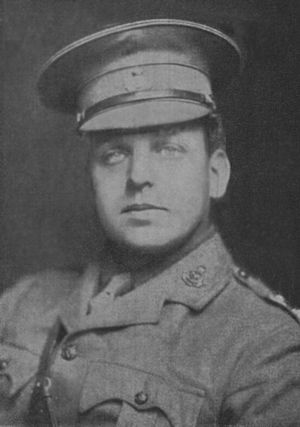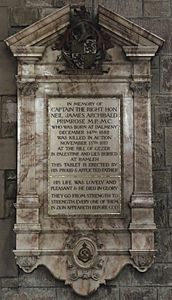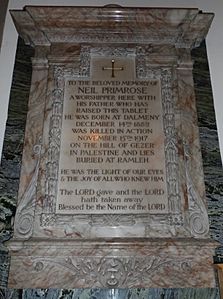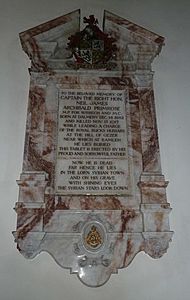Neil Primrose (politician) facts for kids
Quick facts for kids
Neil Primrose
|
|
|---|---|
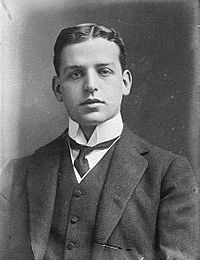
Neil Primrose
|
|
| Parliamentary Secretary to the Treasury with Lord Edmund Talbot |
|
| In office 14 December 1916 – 2 March 1917 |
|
| Monarch | George V |
| Prime Minister | David Lloyd George |
| Preceded by | Lord Edmund Talbot John Gulland |
| Succeeded by | Lord Edmund Talbot Hon. Frederick Guest |
| Personal details | |
| Born | 14 December 1882 Dalmeny House, Dalmeny, Midlothian |
| Died | 15 November 1917 (aged 34) Gezer, Palestine |
| Resting place | Ramleh Commonwealth War Graves Commission Cemetery |
| Nationality | British |
| Political party | Liberal |
| Spouses | Lady Victoria Stanley (1892–1927) |
| Children | Ruth Wood, Countess of Halifax |
| Parents | Archibald Primrose, 5th Earl of Rosebery Hannah de Rothschild |
| Awards | Military Cross |
| Military service | |
| Allegiance | |
| Branch/service | British Army |
| Years of service | 1909–1917 |
| Rank | Captain |
| Unit | Royal Buckinghamshire Hussars |
| Battles/wars | First World War |
Neil James Archibald Primrose (born 14 December 1882 – died 15 November 1917) was a British politician and soldier. He was a member of the Liberal Party.
Neil Primrose was the second son of Lord Rosebery, who was once the Prime Minister. Neil served as a Member of Parliament (MP) for Wisbech from 1910 to 1917. He also held important government jobs. Sadly, he died from injuries during a battle in Palestine in 1917.
Contents
Early Life and Education
Neil Primrose was born in Dalmeny House in Midlothian, Scotland. His father, Archibald Primrose, 5th Earl of Rosebery, was the Prime Minister to Queen Victoria from 1894 to 1895. His mother was Hannah de Rothschild.
He had an older brother, Harry Primrose, 6th Earl of Rosebery, and a sister, Lady Sybil Grant. Neil went to school at Eton and then studied at Oxford. While at Oxford, he was a skilled polo player and also enjoyed steeplechase riding.
Political Journey
Neil Primrose became a Member of Parliament (MP) for Wisbech in January 1910. An MP is someone elected to represent people in the House of Commons, which is part of the UK Parliament.
In 1915, he became the Under-Secretary of State for Foreign Affairs. This role meant he helped the government deal with other countries. Later, in December 1916, when David Lloyd George became Prime Minister, Neil Primrose was made a joint-Parliamentary Secretary to the Treasury. This job involved managing government business in Parliament. In June 1917, he became a member of the Privy Council, a group of important advisors to the King.
Military Service
Neil Primrose joined the Buckinghamshire Yeomanry in 1909. He was promoted to Captain in 1915. He received the Military Cross in June 1916 for his bravery.
In November 1917, he was fighting in the Sinai and Palestine Campaign during the First World War. He was leading his squadron of soldiers against Turkish forces near Gezer. He was badly wounded during this battle, known as the Third Battle of Gaza, and sadly died from his injuries.
Remembering Neil Primrose
When people in the UK heard about Neil Primrose's death, many were very sad. The Prime Minister, David Lloyd George, spoke about him in Parliament on 19 November 1917. He said that Neil Primrose was a bright and kind person with great potential. He chose to serve in a dangerous role and died bravely leading his troops.
The former Prime Minister, H. H. Asquith, also spoke, expressing deep sympathy for Neil's family.
Neil Primrose is buried in the Ramleh Commonwealth War Graves Commission Cemetery in Ramla, which is now in Israel. His gravestone has a special message: "HE LIVES BY LOVE".
He is also remembered on the Parliamentary War Memorial in Westminster Hall, which lists Members of Parliament who died during World War I. There are also special shields in the Commons Chamber that honor him. A book of remembrance was created in 1932 for the House of Commons, which includes a short story about his life.
His father also put up memorial tablets in several churches:
- St Giles' Cathedral, Edinburgh
- Church of St Mary the Virgin, Mentmore, Buckinghamshire
- Christ Church, Epsom Common, Surrey
Other memorials include a stained glass window in St Mary's Church, Knowsley, Merseyside, and a plaque in All Saints Church, Postwick, Norfolk.
- Memorials erected to the memory of Neil Primrose by his father
-
Christ Church, Epsom Common
Family Life
Neil Primrose married Lady Victoria Stanley on 7 April 1915. Her father was Edward Stanley, 17th Earl of Derby.
They had one daughter:
- Ruth Alice Hannah Mary Primrose (born 18 April 1916 – died 1989). She later married Charles Wood, 2nd Earl of Halifax.
After Neil's death, Lady Victoria married Malcolm Bullock. She died in a hunting accident in November 1927.


